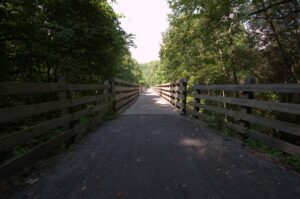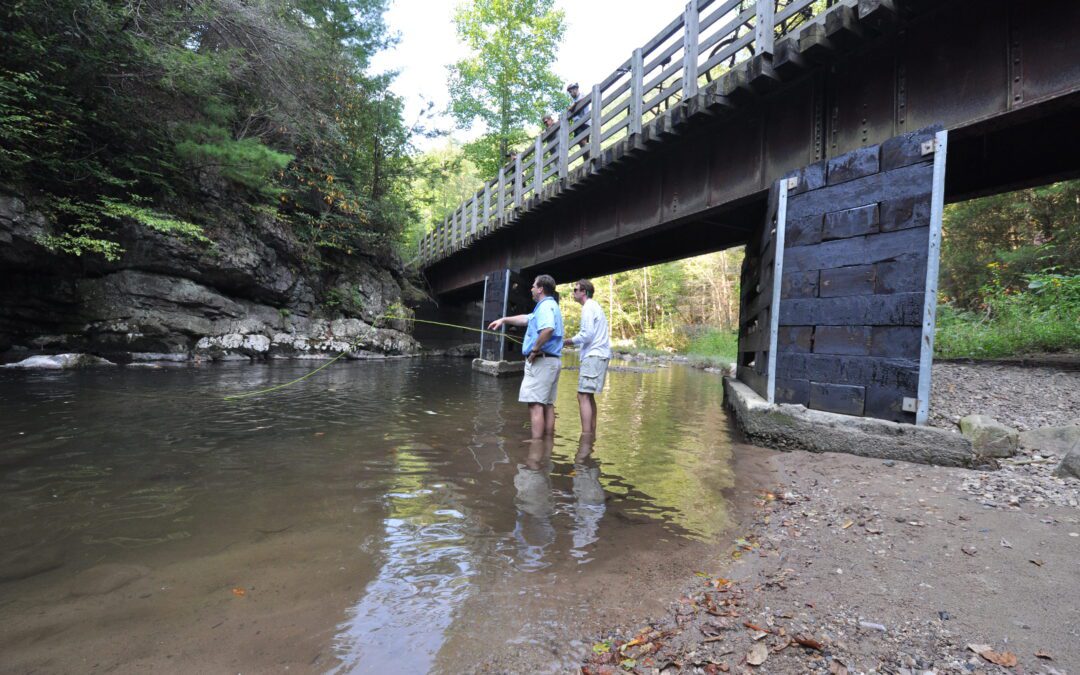Nestled within the scenic landscapes of Virginia’s southwestern region lies a town steeped in history and brimming with tales of the past—Damascus, VA. While often recognized as a haven for outdoor enthusiasts, Damascus also holds a captivating historical heritage that adds depth and character to its charm. In this blog post, we will embark on a journey through time, uncovering the fascinating history of Damascus from its early beginnings to its transformation into the hidden gem it is today.
The Birth of Damascus: Naming and Origins
The origins of Damascus, VA, can be traced back to the early settlements that took root in the region. The town’s name itself carries a sense of intrigue and mystery, as its origin remains a topic of speculation among historians. One prevailing theory suggests that the name “Damascus” was inspired by the biblical city in present-day Syria, evoking a sense of exoticism and mystique. Others speculate that the name may have been derived from a local family or a Native American word. Regardless of its true etymology, the name Damascus adds to the town’s allure and captures the imagination of those who explore its history.
The early years of Damascus were marked by the establishment of a close-knit community. Settlers were drawn to the area’s abundant natural resources, including fertile land and nearby waterways. As families and individuals began to build homes and businesses, a sense of community spirit took hold, laying the foundation for the town’s growth and development. Early industries, such as farming, logging, and mining, played a significant role in shaping Damascus’ economy and way of life.
Infrastructure development was a key aspect of Damascus’ early years. As the town expanded, roads and bridges were constructed to facilitate travel and trade. The construction of churches, schools, and other communal buildings further solidified the sense of community and provided essential services to residents. While initially a small settlement, Damascus began to establish itself as an important center in the region, setting the stage for the town’s future as a railroad hub and later as a trail town renowned for its outdoor adventures.
The birth of Damascus, VA, was marked by the convergence of settlers, natural resources, and community spirit. The town’s name, shrouded in mystery, adds an air of fascination to its origins. From its humble beginnings as a close-knit community to its subsequent growth and development, Damascus laid the groundwork for its future as a significant transportation hub and a destination for outdoor enthusiasts. Exploring the history of Damascus reveals the enduring spirit of its early settlers and the captivating journey that has shaped it into the hidden gem it is today.
The Early Years: Foundations of a Railroad Town and The Railroad Boom
In the 19th century, the introduction of railroads revolutionized transportation and had a profound impact on the development of Damascus, VA. The town’s growth can be attributed to the railroad boom that swept across the United States during this period. The construction of the Virginia-Carolina Railway played a pivotal role in shaping Damascus into a bustling railroad town.
As rail lines expanded and connected various regions, Damascus emerged as a vital transportation hub. The town’s strategic location at the intersection of several rail lines made it a key point for freight and passenger transportation. The railroad not only facilitated the movement of goods but also brought people and commerce to Damascus, contributing to its economic prosperity.
The arrival of the railroad brought about a period of rapid growth and development in Damascus. The construction of rail infrastructure led to an influx of workers and businesses, fueling the town’s expansion. Industries such as logging, agriculture, and mining flourished as they now had an efficient means of transporting their products to larger markets. The railroad also opened up opportunities for trade and commerce, transforming Damascus into a bustling center of activity.
Damascus’ status as a railroad town in the 19th century left an indelible mark on its history and character. The growth and prosperity brought by the railroad boom laid the foundations for the town’s future development and set the stage for the transformation it would undergo in the decades to come. Today, remnants of Damascus’ railroad heritage can still be seen, serving as a reminder of the town’s early years and the crucial role it played in the transportation revolution of the 19th century.
The Railroad Era: Damascus’ Role in Transportation and Trade
 During the railroad era, Damascus, VA, played a crucial role in the transportation and trade networks of the region. As a thriving railroad town, Damascus became a vital hub for both freight and passenger transportation, facilitating the movement of goods and people across the country. The railroad brought an unprecedented level of connectivity and accessibility to the town, opening up new opportunities for economic growth and development.
During the railroad era, Damascus, VA, played a crucial role in the transportation and trade networks of the region. As a thriving railroad town, Damascus became a vital hub for both freight and passenger transportation, facilitating the movement of goods and people across the country. The railroad brought an unprecedented level of connectivity and accessibility to the town, opening up new opportunities for economic growth and development.
The Damascus Depot stood as a testament to the town’s importance in the railroad era. Serving as a central point for train arrivals and departures, the depot was a bustling hub of activity. It not only played a practical role in facilitating transportation but also served as a social gathering place for locals and travelers alike. The depot’s architectural significance and historical value have been recognized, and efforts have been made to preserve this iconic landmark, allowing visitors to step back in time and imagine the bustling scenes of the railroad era.
Damascus’ role in transportation and trade extended beyond its own borders. The town became a vital link in the larger network of rail lines, connecting it to major cities and markets. This connectivity allowed local industries to thrive and contributed to the town’s economic prosperity. The railroad enabled the efficient transportation of resources such as timber, coal, and agricultural products, providing a boost to the local economy and attracting new businesses to the area.
The railroad era marked a transformative period for Damascus, as it emerged as a significant player in transportation and trade. The town’s strategic location and well-connected rail lines made it an essential hub in the region, facilitating the movement of goods and people. The Damascus Depot stood as a symbol of the town’s importance, both practically and socially. The railroad’s impact on the local economy and its role in shaping the town’s identity cannot be overstated. The legacy of Damascus’ railroad era continues to be celebrated, reminding us of the pivotal role this hidden gem played in the transportation networks of the past.
From Rails to Trails: Damascus as a Trail Town
 The transformation of Damascus, VA, from a railroad town to a renowned trail town is a remarkable testament to the town’s adaptability and appreciation for its natural surroundings. With the decline of the railroad industry, visionaries in the community recognized an opportunity to repurpose the rail lines into recreational trails. This transformative idea gave birth to the Virginia Creeper Trail, a scenic pathway that attracts outdoor enthusiasts from near and far.
The transformation of Damascus, VA, from a railroad town to a renowned trail town is a remarkable testament to the town’s adaptability and appreciation for its natural surroundings. With the decline of the railroad industry, visionaries in the community recognized an opportunity to repurpose the rail lines into recreational trails. This transformative idea gave birth to the Virginia Creeper Trail, a scenic pathway that attracts outdoor enthusiasts from near and far.
The Virginia Creeper Trail, stretching over 34 miles, winds its way through picturesque landscapes, crossing trestle bridges and passing by tranquil streams. It offers a range of outdoor activities, including biking, hiking, and horseback riding. Damascus serves as a pivotal point along the trail, acting as a gateway town and providing essential amenities and services to visitors. The trail not only showcases the natural beauty of the region but also pays homage to Damascus’ railroad heritage by following the path once traveled by steam engines and railcars.
Damascus has become synonymous with the Appalachian Trail, further solidifying its status as a trail town. The town sits at the intersection of the Appalachian Trail and the Virginia Creeper Trail, making it a popular destination for hikers and outdoor adventurers. Through-hikers, as well as day-trippers, flock to Damascus to resupply, rest, and soak in the warm hospitality of the community. Trail Days, an annual festival held in Damascus, celebrates the Appalachian Trail spirit and brings together hikers, outdoor enthusiasts, and locals in a vibrant celebration of trail culture.
The transition of Damascus from a railroad town to a trail town highlights the town’s ability to adapt and embrace its natural surroundings. The Virginia Creeper Trail and its connection to the Appalachian Trail have firmly established Damascus as a premier destination for outdoor recreation. The town’s rich trail culture, coupled with its warm hospitality, attracts visitors seeking to immerse themselves in nature, embark on epic hikes, or simply enjoy a leisurely bike ride. Damascus has successfully leveraged its past and transformed it into a thriving present, becoming a true haven for those who cherish the great outdoors.
Damascus’ role as a gateway town to the Appalachian Trail
Nestled at the crossroads of the Virginia Creeper Trail and the Appalachian Trail, Damascus, VA, has earned its reputation as a premier gateway town to the Appalachian Trail. As hikers embark on their journey along the iconic trail, Damascus serves as a welcoming and essential stop along the way. The town offers a range of services and amenities, catering to the needs of weary hikers and providing a much-needed respite before continuing their trek through the rugged wilderness.
Damascus’ proximity to the Appalachian Trail makes it an ideal location for hikers to resupply and rest. The town boasts numerous outfitters, gear shops, and grocery stores, ensuring that hikers have access to the necessary equipment and supplies for their expedition. The warm hospitality of the locals and the welcoming atmosphere of the town create a sense of camaraderie and community among hikers, fostering an environment of support and encouragement.
Beyond its practical role, Damascus embraces its identity as a gateway town and celebrates the spirit of the Appalachian Trail. The annual Trail Days Festival, held in Damascus, attracts hikers, outdoor enthusiasts, and trail enthusiasts from all over the country. This vibrant festival brings together a diverse community of individuals who share a passion for the trail, featuring live music, gear vendors, educational workshops, and the famous hiker parade. Trail Days is a testament to the town’s commitment to preserving and promoting the Appalachian Trail culture.
Damascus plays a vital role as a gateway town to the Appalachian Trail, providing essential services and fostering a sense of community for hikers embarking on their Appalachian Trail adventure. The town’s strategic location, warm hospitality, and celebration of trail culture make it a cherished destination among thru-hikers and outdoor enthusiasts. Damascus stands as a testament to the enduring spirit of the Appalachian Trail and serves as a beacon of support and respite for those who seek the challenge and beauty of this iconic trail.
Historic Buildings and Preservation Efforts
 Damascus, VA, boasts a rich architectural heritage, with a number of historic buildings that have withstood the test of time. These buildings not only serve as visual reminders of the town’s past but also contribute to its unique charm and character. Recognizing the importance of preserving these architectural treasures, Damascus has seen ongoing efforts to protect and maintain its historic buildings, ensuring that future generations can appreciate their significance.
Damascus, VA, boasts a rich architectural heritage, with a number of historic buildings that have withstood the test of time. These buildings not only serve as visual reminders of the town’s past but also contribute to its unique charm and character. Recognizing the importance of preserving these architectural treasures, Damascus has seen ongoing efforts to protect and maintain its historic buildings, ensuring that future generations can appreciate their significance.
One notable historic building in Damascus is the Old Mill Inn. Originally constructed in the early 19th century as a grist mill, it has been lovingly restored and transformed into a charming inn. The Old Mill Inn is not only an architectural gem but also an embodiment of Damascus’ commitment to historic preservation. Its preservation and repurposing demonstrate the town’s dedication to breathing new life into its historic structures, allowing visitors to experience the past while enjoying modern comforts.
The preservation efforts in Damascus extend beyond the Old Mill Inn. The town has taken steps to protect other historic buildings, such as the Damascus School, which now serves as a community center. These preservation initiatives not only safeguard the physical structures but also contribute to the overall cultural heritage of Damascus. By preserving and repurposing these buildings, the town celebrates its history and creates spaces that foster community engagement and cultural exchange.
The preservation of historic buildings in Damascus, VA, highlights the town’s commitment to honoring its past and embracing its cultural heritage. The Old Mill Inn and other historic buildings serve as tangible links to Damascus’ history, showcasing the town’s architectural diversity and rich legacy. Through ongoing preservation efforts, Damascus ensures that these
buildings remain integral parts of the community, allowing visitors to appreciate their beauty and significance for years to come. The preservation of historic buildings not only enhances the visual appeal of the town but also fosters a sense of pride and identity among its residents.
As we conclude our exploration of the rich history of Damascus, VA, we unveil a tapestry of narratives that have shaped this hidden gem. From its humble beginnings as a railroad town to its transformation into a renowned trail town, Damascus has witnessed the ebb and flow of time, preserving its heritage while embracing its natural beauty. The historical landmarks, architectural treasures, and community spirit that prevail in Damascus serve as a testament to its resilience and the enduring legacy of those who have called it home. As visitors explore the town’s streets and trails, they are invited to immerse themselves in the captivating tales of the past, fostering a deeper appreciation for the hidden gem that is Damascus, VA.

